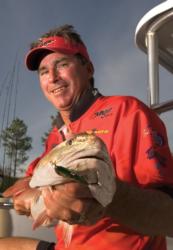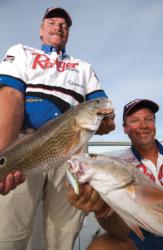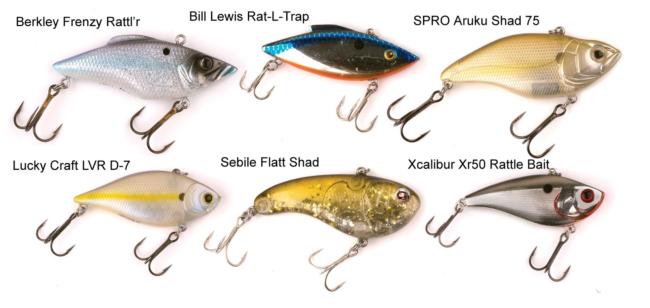Rattling racketeers
Redfish pros spill their secrets on fishing lipless crankbaits

As dawn broke at the day-one launch of the Wal-Mart FLW Redfish Series event in Fernandina Beach, Fla., last May, I began to busily nose my way through the lures redfish pros had tied to their rods.
With each boat that came through boat check, I observed the usual suspects: gold spoons, topwaters, jigs, soft-plastic jerkbaits, and even a spinnerbait or two – nothing too suspicious.
Then something rather odd tied to one particular rod caught my eye.
“Is that a Bill Lewis Rat-L-Trap?” I blurted out before I even fully recognized the anglers behind the wheel of the boat carrying the lure.
“Yep,” replied Gary McKenzie of Bartow, Fla., who fishes the FLW Redfish Series with team partner, Sam Bertha Jr. of Bunnell, Fla.
I quickly fumbled for my notepad like an overzealous law officer who had witnessed a minor traffic violation. I frantically scribbled: Rat-L-Trap – McKenzie-Bertha.
This was not the first time I had seen rattling lipless crankbaits go through boat check in a Redfish Series event. I had spied several of the lures tied onto rods during the Lafitte, La., event as well.
Later that day I reviewed my other notes from the 2007 season and found another key piece of evidence scribbled on a memo pad: Rat-L-Trap? VanDemark-Shaw? It was just the clue I needed to launch an investigation into this unconventional redfishing rattler.
I started by questioning one of my ace undercover informants in the Redfish Series who knows the redfish pros and their techniques.
“Gary McKenzie, street name G-Mac,” my insider said. “He’s a former bass angler who has adapted the Rat-L-Trap for saltwater use on redfish. Also, check into Troy Robichaux from Lockport, La. He grew up using Rat-L-Traps to catch bass, and now he uses them to catch redfish.”
Bingo! I was hot on the trail of some rattling racketeers. My first interrogation was of Tadd VanDemark of Key Largo, Fla.
Over the last two seasons, VanDemark’s Redfish Series stats have been impressive. In 2006, he won the Wal-Mart FLW Redfish Series Championship in Pensacola, Fla., while fishing with then partner Blair Wiggins of Palmetto, Fla.
During the 2007 season, he teamed up with Kevin Shaw of Corpus Christi, Texas, and has since added another FLW Redfish Series trophy to his mantle from Port Aransas, Texas.
VanDemark and Shaw ended up winning the 2007 FLW Redfish Series Western Division points title with a total of 584 points, just 16 points shy of a perfect season.
 “As more guys start looking offshore in deeper water for redfish, we are finding that rattling lipless crankbaits are an efficient tool for covering water and locating fish in that 4- to 10-foot zone,” VanDemark explained. “Kevin and I have been using them for quite some time.”
“As more guys start looking offshore in deeper water for redfish, we are finding that rattling lipless crankbaits are an efficient tool for covering water and locating fish in that 4- to 10-foot zone,” VanDemark explained. “Kevin and I have been using them for quite some time.”
While McKenzie and Robichaux both prefer the original Bill Lewis Rat-L-Traps in the standard 1/2-ounce size, VanDemark has taken a liking to the Sebile Possessed Flatt Shad lipless rattler.
“The 54-millimeter Flatt Shad is the 1/2-ounce size, and the 77-millimeter is more like a 3/4-ounce,” VanDemark noted. “We use the 54-millimeter one the most.”
Rattling the rocks
In a sport that demands the silence of a church mouse, using a loud rattler for redfish seems a bit counterintuitive. Why would an angler want to sling a big plastic lure full of clacking BBs to redfish? I could not come up with a motive for this rather unusual approach until VanDemark provided one.
“If you think about redfishing from a traditional standpoint – poling gin-clear flats in inches of water – it’s not that type of lure,” he explained. “Lipless rattlers are for probing unconventional redfish water – deeper water cover like bridge abutments, pilings, riprap, jetties, oyster bars, drops and channels.”
VanDemark admitted such types of water are more prevalent in the western Gulf of Mexico and up the East Coast.
“The bottom two-thirds of the state of Florida is not exactly great crankbait water,” he said. “But from about Homosassa (Fla.) west to Alabama, Louisiana and Texas, and from about St. Augustine (Fla.) to the north up the East Coast, lipless rattling crankbaits are first-string players for us – we always have a Flatt Shad tied on.
“They are such awesome search baits,” VanDemark continued. “Kevin and I have both found some of our best tournament spots and schools while covering water with the Flatt Shad in practice.”
One such discovery came this year in Rockport, Texas, when the team was fishing down a bank and had to go under a bridge.
“As we were trolling under the bridge, I picked up a Flatt Shad and slung it out the other side to a bridge piling, let it sink and hopped it up off the bottom, and whammo, I caught a nice redfish,” VanDemark said. “After some investigation, we discovered a little washed-out hole under the bridge that was loaded with a huge school of reds. We would have never found those fish if I hadn’t made a cast out there when we were going by – a lipless rattler lets you make those kinds of off-the-wall queries to deeper water to make sure you’re not missing anything.
“Think cover and structure, preferably in water about 3 to 10 feet. And you want to contact that cover with the lure,” he said.
For that reason, VanDemark’s favorite place to use his Flatt Shad is around rock.
“Inlets and passes that are lined with jetties are primo redfish spots all year long, especially in the western Gulf,” he explained. “And there is no better lure to search along a line of jetty rocks than a lipless rattler. You can fire it out there, let it sink and start slow-rolling it down around the big boulders. And it doesn’t just catch redfish, either. You’ll get slammed by blues, jacks, trout, flounder – anything that’s using those rocks to ambush bait will eat it.”
Riprap and concrete bridge abutments are key rattling locations, too.
“What’s a concrete bridge support?” VanDemark questioned. “Just a giant rock that breaks current and attracts bait, the two main ingredients for attracting redfish. And a lipless rattler is a fast, efficient way to probe those big concrete supports.”
Bashing the beaches
In addition to the hard structure VanDemark seeks out for a lipless rattler, McKenzie adds outside beaches to his list.
“I love fishing beaches for redfish,” McKenzie related. “A lot of bigger redfish migrate down the beaches at all times of the year. They like to travel along the bars and troughs formed by wave action.”
 McKenzie often rides the beaches in his boat looking for schools of reds. And once he sees a school, the first thing he starts launching at them is a 1/2-ounce Rat-L-Trap.
McKenzie often rides the beaches in his boat looking for schools of reds. And once he sees a school, the first thing he starts launching at them is a 1/2-ounce Rat-L-Trap.
“The best place to start looking is right there on the first bar where the waves break,” he said. “Reds like that zone because the surf roils up the bottom, and reds have a feeding advantage.”
McKenzie positions his boats just to the outsides of the breakers and makes long parallel casts down the primary bar.
“Obviously the conditions have to be right,” he noted. “You can’t do this in 5-footers. But a nice, calm day when there is some surf crashing the beach is perfect. Also, you have to be careful with your boat position. You don’t want to get inside those breakers, or you’ll swamp your boat.
“Moving water is my primary consideration for Rat-L-Traps.” McKenzie continued. “Redfish love to get into some kind of moving water to help them feed, which is why they like that surf zone on the beach.”
McKenzie agreed the crystal-clear, calm flats of much of Florida’s inshore water may not be the best places for a Rat-L-Trap under normal conditions, but if abnormal conditions occur, it’s his go-to.
“It is definitely an outside-the-box type of bait,” he said. “Under normal, flat, calm conditions in shallow, clear water, it would not be tops on my list. But when I see a condition out of the ordinary like a super-high tide up on the flats, a lot of moving water, maybe an influx of off-colored water, even wind that ruffles the surface or pushes high water into places – I think Rat-L-Trap.”
Taking the fall
When Robichaux talks Rat-L-Traps, he talks “fall,” as in the season, the water temperature and the water levels.
“Fall is the best time for Rat-L-Traps from here (Louisiana) to Texas,” Robichaux remarked. “During the fall of the year, the water temperature drops and we start having lower-than-average tides. When water starts falling out of the marshes into ditches, drains and main channels, the reds stack up in those places where the water is running out, and they gorge themselves on bait. That’s when Rat-L-Traps are prime.”
Away from home, Robichaux has also come to depend on Rat-L-Traps anytime he can access the Intracoastal Waterway.
“The ICW runs through a lot of the tournament venues in the East like Jacksonville, St. Augustine, Pensacola and Orange Beach,” he noted. “I like fishing the ICW because it’s just like bass fishing. There is a lot of solid cover like laydowns, docks, old pilings, seawalls, creek mouths and oyster bars along the ICW. And when I go scouting on the ICW, I put a Rat-L-Trap in my hand and cover water.”
One of the most important differences Robichaux has learned in throwing traps for redfish over bass is to slow-roll the Rat-L-Trap with a steady cadence.
“Guys who have fished Rat-L-Traps for bass know that `ripping’ the bait hard out of grass cover often provokes the strike,” he offered. “Redfish are a bit different. They don’t tend to react on a hard rip-and-fall retrieve of the lure. They like more of a steady, slow roll with a light snap of the rod tip from time to time, especially when contacting cover.”
All three of these rattling experts believe this unconventional style of redfishing is going to become much more of the norm in tournament redfishing in the coming years.
“Sight-fishing is a lot of fun, but everyone does it,” VanDemark said. “Once a hundred boats start running the flats looking for fish, those fish become way too spooky. And what we are starting to discover is that there is a whole world of redfish out there in the deeper water – redfish that are less pressured and way less skittish. And a rattling lipless crankbait is a good way to find those untapped fish.”

Rattling equipment
One of the appealing attributes of a rattling lipless crankbait is how user-friendly the lure is for beginners and pros alike.
The most common rod-and-reel combo for Rat-L-Traps is a medium-action casting outfit in the 7-foot range with plenty of tip. If you are uncomfortable with casting tackle, it’s not a problem. VanDemark and Shaw throw their Flatt Shads on spinning rods exclusively.
No matter which outfit is selected, braided line is the way to go for the main line on the reel. All pros featured in this article use braided line in the 20- to 50-pound class, depending on the cover being fished. Also, some prefer a fluorocarbon leader of 20- to 40-pound-test.
Robichaux, who typically fishes the off-colored waters of Louisiana, uses a 50-pound braid and ties directly to the braid with no leader.
“Line size doesn’t matter as much in Louisiana as it does in some parts of the country,” he suggested.
McKenzie, on the other hand, will go with a 40-pound braid tied to a 25-pound leader when fishing slick places like the beaches, but opts for a 50-pound braid and a 40-pound leader when fishing around hard cover.
Finally, having a rod with plenty of tip and a reel with a good drag is imperative to landing fish on a Rat-L-Trap.
“Redfish will pull off on treble hooks,” Robichaux explained. “They have such power that they can easily pull free or rip your split rings off the bait.”
For that reason, Robichaux shies away from heavy and medium-heavy rods and prefers one with a fast tip that is more forgiving when a red makes a sudden burst.
“Also, set your drag as loose as you can stand it,” Robichaux added. “When I’m fishing Rat-L-Traps, I set my drag very loose. I want that drag to give from the moment the fish bites and makes that first run. If the drag is too tight and there is no give in the system, they’ll just pull off.”
Color, hooks and split rings
When it comes to color selection for lipless rattlers, just about anything in a gold, copper, silver, white, gray or shad will work. Redfish are not picky about colors with this hard bait.
Also, these rattling racketeers all upgrade their hardware on their lipless rattlers.
McKenzie replaces his stock split rings with SPRO split rings and beefs up his hooks with Owner trebles, No. 2 on the front and No. 4 on the back.
Robichaux also upgrades everything with oversized stainless-steel split rings and bigger Owner or VMC hooks.
VanDemark said the Flatt Shad is ready to go out of the package but noted that after a lot of use, the hooks will have to be changed.
“Constant hook changing is a given with any kind of crankbait,” VanDemark said. “Hard structure dulls the hook points, and redfish will actually bend and mash the trebles together with the power of their jaws. So we will change our hooks out every few days with Eagle Claw No. 2s and No. 4s.”